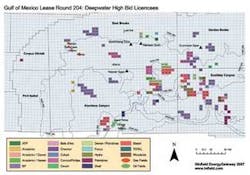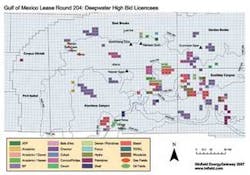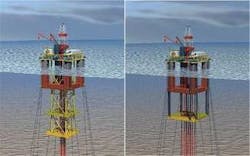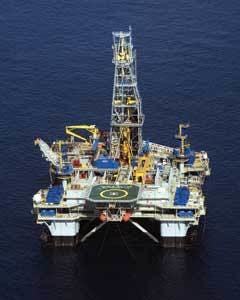GULF OF MEXICO
David Paganie, Houston
Statoil outspends in Sale 204
Statoil was the big spender by far in Western Gulf of Mexico Oil and Gas Lease Sale 204, according to MMS statistics. The company placed $139 million in high bids on 36 tracts, followed by a distant $31 million in high bids on 91 tracts from BP. Statoil’s single highest bid ($38 million for Alaminos Canyon block 810) was more than the total amount of all high bids from BP ($31 million).
The company’s high bids include 20 in the Alaminos Canyon area and 16 in the Keathley Canyon area, all in deepwater. Statoil will be the 100% owner and operator of all those leases awarded, pending final MMS approval. The block in the lease sale that received the highest number of bids (seven) was Keathley Canyon block 94. Devon Energy with partner Petrobras submitted the highest bid at $15 million.
Lease Sale 204 attracted $369,496,840 in bids from 47 companies, down from $462,760,912 from 62 companies in Western Lease Sale 200 in 2006, according to the MMS. Participants submitted 358 bids on 282 tracts, down from 541 bids on 381 tracts in 2006. A total of 3,338 tracts were offered in Sale 204, down 14% from Sale 200 in 2006, due in part to the revised Western Planning Area, which reduced associated acreage.
The single highest bid of $38 million in 2007 is up from $21 million in 2006. Bids on ultra deepwater tracts had the most notable change year over year, according to the MMS. In Sale 204, in water depths greater than 2,000 m (6,562 ft), $122.9 million ($106 million in high bids) was bid on 30 blocks, up from $16.1 million ($12.5 million in high bids) bid on 22 blocks in the same water depth in 2006.
Rounding out the Top 10 high bidders in Sale 2004 were Petrobras, Devon, ConocoPhillips, Hydro, LLOG, Bois d’Arc, Shell, and Anadarko.
FloaTEC introduces dry tree semi
FloaTEC introduced at Offshore Europe in Aberdeen, Scotland, a dry tree floating production concept which it plans to have ready for the market in 2008 for Gulf of Mexico and West Africa deepwater development.
FloaTEC says it plans to deliver all major components of the dry tree production semi fitted with a large drilling rig, from its JV parents J. Ray McDermott and Keppel FELS’ multiple yards on the Gulf Coast, reducing project risk and schedule through a high degree of self-performance from engineering through construction and installation.
This gives FloaTEC an advantage in securing deepwater development contracts in the GoM, where some projects are slipping by an average of two years, said Eric Namtvedt, FloaTEC president, at the announcement.
“We have the potential to create a market space where competition is irrelevant,” said Namtvedt. “Many deepwater projects in the Gulf are slipping because of the lack of experienced industry personnel, limited rig availability, rising construction costs impacting project economics, long-lead delivery times for key components, and limited spare yard capacity,” he said. “FloaTEC, working with our JV parents, has the resources to handle lumpsum, EPCI risks for deepwater developments, which can recover some of the loss from these projects slipping. We will design, build, integrate, and deliver the complete dry tree floating production units from the Gulf Coast.”
Benefits of using this deepwater production solution, according to FloaTEC, include:
- Lower drilling costs
- Avoiding the need for high-cost mobile offshore drilling units for development drilling and workover operations
- Reduced installation costs - quayside integration eliminates the need for a heavy-lift vessel for installation and hookup
- Lower operating costs - dry trees eliminate subsea intervention.
But the key advantage is higher recovery rates, Namtvedt said. FloaTEC is completing final model tests on the dry tree semi concept.
Petrobras contracts BW Offshore for FPSO
Petrobras America Inc. has selected BW Offshore Ltd. to convert, install, and operate an FPSO at Chinook and Cascade. The $740-million contract, subject to board approvals from Petrobras and partners, also will cover delivery and installation of an APL disconnectable submerged turret production buoy and mooring system.
The schedule calls for installation of the FPSO early in 2010 with first production in 1Q 2010.
The FPSO is specified to have 600,000 bbl of oil storage capacity, 80,000 b/d of oil processing capacity, and 16 MMcf/d of natural gas export capacity.
Water depth at Chinook and Cascade is 2,600 m (8,530 ft).
Aker Kværner completes Blind Faith
Aker Kværner has completed the semisubmersible hull for Chevron’sBlind Faith platform.
Chevron and partner Anadarko awarded the original engineering, procurement, and construction contract to Aker Kværner Inc. in Oct. 2005. The semisubmersible left the Aker Kværner Verdal yard in Norway on June 24 for a Gulf of Mexico yard, to be outfitted with the topsides.
TheBlind Faith platform is the first application of Aker Kværner’s deep draft semisubmersible concept, which was conceived specifically to use steel catenary risers in the ultra deepwater and current-heavy GoM environment.
Aker Marine Contractors managed the dry transportation of the semisubmersible hull, namedFrøya, to the GoM using Dockwise’s HLV Tern as the transport vessel.
Blind Faith will be in Mississippi Canyon block 650, 162 mi (261 km) southeast of New Orleans in 6,500 ft (1,981 m) water depth.
Meanwhile, Subsea 7’s new pipelay vesselSeven Oceans was loading two 7-km (4.4-mi) long, 7-in. (18-cm) diameter pipelines for the project. Installation was scheduled to begin by early October.
The 157-m (515-ft) long vessel is fitted with a main reel capable of carrying 3,500 tons (3,175 metric tons) of rigid steel pipe and a 400-ton (363-metric ton) tensioner, allowing installation in water depths to 3,000 m (9,842 ft). A lay ramp system for deployment of rigid products 6-16 in. (15.25-40.6 cm) in diameter is permanently installed. The vessel can accommodate a crew of 120.
Deepwater Specialists to commission Perdido hub
Shell Offshore Inc. has selected John Wood Group company, Deepwater Specialists Inc. (DSI), to commission thePerdido regional host facility, which will be installed in the Alaminos Canyon area of the Gulf.
DSI’s work scope includes the development of the commissioning plan and schedule, functional test procedures, the site materials control plan, permit-to-work system, commissioning control and reporting process, and the commissioning certification database.
DSI will coordinate mechanical completion activities and documentation with the construction teams in Ingleside and Houston, both in Texas, and in Pori, Finland, during hull, topsides, and quarters fabrication. The company will carry out final functional and dynamic testing of the integrated facility offshore prior to first oil.
DSI says it has commissioned other Shell projects including theBrutus TLP, Ursa-Crosby subsea tieback, Na Kika semisubmersible, Mars water flood, Bonga FPSO, and the Ursa-Princess water flood project.
Noble Denton secures Thunder Hawk warranty
SBM Atlantia has awarded Noble Denton Marine Services Inc. the marine warranty for the semisubmersibleThunder Hawk.
Denton’s work scope includes the review and attendance for the hull and deck loadout, transport, offload, deck integration lift, tow to site, and installation.
TheThunder Hawk design is based on Atlantia’s deep draft semi. It will have capacity to produce up to 60,000 b/d of oil and 70 MMcf/d of gas. The SBM Atlantia-owned semi will be installed on the Murphy-operated Thunder Hawk field by Aker Marine Contractors in 4Q 2008.
The installation campaign is scheduled to start in mid-May 2008, with the setting of mooring piles in 1,800 m (5,905 ft) water depth.
Versabar says it has lifted the largest Katrina-toppled deck since the hurricane hit the GoM about two years ago. The company used itsBottom Feeder to salvage Chevron’s 1,400-ton (1,422-metric-ton) topsides from the seafloor in 240 ft (73 m) of water.
The company says the sunken deck was raised above water and set on a barge bound for shore in 3.5 hours. The lifting system has capacity to handle up to 4,000 tons (4,064 metric tons). Since theBottom Feeder was launched, it has lifted five decks from the seafloor, according to Versabar.
Noble Drilling is upgrading the mooring systems of its GoM-based semisubmersible fleet. TheNoble Clyde Boudreaux was first in line. Its mooring system has been upgraded from eight-point to 16-point. The rig also was fitted with a real-time monitoring and positioning system.
Noble says it plans to finish all scheduled rig upgrades by the spring of 2008. At print,Noble Clyde Boudreaux was working for Shell in Alaminos Canyon block 857 in 8,700 ft (2,652 m) of water.




